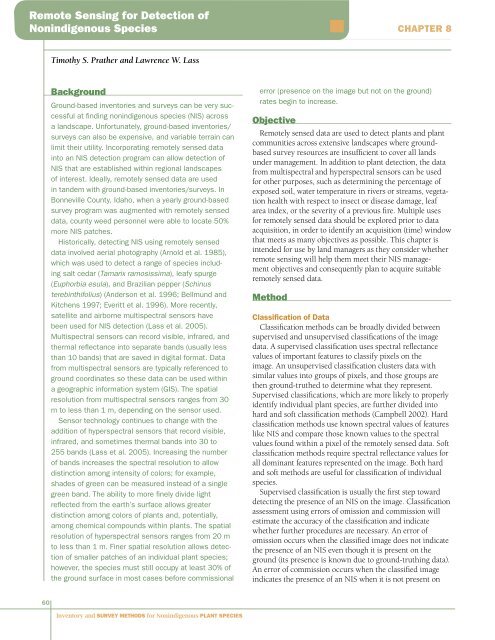Inventory and Survey Methods for Nonindigenous Plant Species (PDF)
Inventory and Survey Methods for Nonindigenous Plant Species (PDF)
Inventory and Survey Methods for Nonindigenous Plant Species (PDF)
- No tags were found...
You also want an ePaper? Increase the reach of your titles
YUMPU automatically turns print PDFs into web optimized ePapers that Google loves.
Remote Sensing <strong>for</strong> Detection of<strong>Nonindigenous</strong> <strong>Species</strong>Chapter 8Timothy S. Prather <strong>and</strong> Lawrence W. LassBackgroundGround-based inventories <strong>and</strong> surveys can be very successfulat finding nonindigenous species (NIS) acrossa l<strong>and</strong>scape. Un<strong>for</strong>tunately, ground-based inventories/surveys can also be expensive, <strong>and</strong> variable terrain canlimit their utility. Incorporating remotely sensed datainto an NIS detection program can allow detection ofNIS that are established within regional l<strong>and</strong>scapesof interest. Ideally, remotely sensed data are usedin t<strong>and</strong>em with ground-based inventories/surveys. InBonneville County, Idaho, when a yearly ground-basedsurvey program was augmented with remotely senseddata, county weed personnel were able to locate 50%more NIS patches.Historically, detecting NIS using remotely senseddata involved aerial photography (Arnold et al. 1985),which was used to detect a range of species includingsalt cedar (Tamarix ramosissima), leafy spurge(Euphorbia esula), <strong>and</strong> Brazilian pepper (Schinusterebinthifolius) (Anderson et al. 1996; Bellmund <strong>and</strong>Kitchens 1997; Everitt et al. 1996). More recently,satellite <strong>and</strong> airborne multispectral sensors havebeen used <strong>for</strong> NIS detection (Lass et al. 2005).Multispectral sensors can record visible, infrared, <strong>and</strong>thermal reflectance into separate b<strong>and</strong>s (usually lessthan 10 b<strong>and</strong>s) that are saved in digital <strong>for</strong>mat. Datafrom multispectral sensors are typically referenced toground coordinates so these data can be used withina geographic in<strong>for</strong>mation system (GIS). The spatialresolution from multispectral sensors ranges from 30m to less than 1 m, depending on the sensor used.Sensor technology continues to change with theaddition of hyperspectral sensors that record visible,infrared, <strong>and</strong> sometimes thermal b<strong>and</strong>s into 30 to255 b<strong>and</strong>s (Lass et al. 2005). Increasing the numberof b<strong>and</strong>s increases the spectral resolution to allowdistinction among intensity of colors; <strong>for</strong> example,shades of green can be measured instead of a singlegreen b<strong>and</strong>. The ability to more finely divide lightreflected from the earth’s surface allows greaterdistinction among colors of plants <strong>and</strong>, potentially,among chemical compounds within plants. The spatialresolution of hyperspectral sensors ranges from 20 mto less than 1 m. Finer spatial resolution allows detectionof smaller patches of an individual plant species;however, the species must still occupy at least 30% ofthe ground surface in most cases be<strong>for</strong>e commissionalerror (presence on the image but not on the ground)rates begin to increase.ObjectiveRemotely sensed data are used to detect plants <strong>and</strong> plantcommunities across extensive l<strong>and</strong>scapes where groundbasedsurvey resources are insufficient to cover all l<strong>and</strong>sunder management. In addition to plant detection, the datafrom multispectral <strong>and</strong> hyperspectral sensors can be used<strong>for</strong> other purposes, such as determining the percentage ofexposed soil, water temperature in rivers or streams, vegetationhealth with respect to insect or disease damage, leafarea index, or the severity of a previous fire. Multiple uses<strong>for</strong> remotely sensed data should be explored prior to dataacquisition, in order to identify an acquisition (time) windowthat meets as many objectives as possible. This chapter isintended <strong>for</strong> use by l<strong>and</strong> managers as they consider whetherremote sensing will help them meet their NIS managementobjectives <strong>and</strong> consequently plan to acquire suitableremotely sensed data.MethodClassification of DataClassification methods can be broadly divided betweensupervised <strong>and</strong> unsupervised classifications of the imagedata. A supervised classification uses spectral reflectancevalues of important features to classify pixels on theimage. An unsupervised classification clusters data withsimilar values into groups of pixels, <strong>and</strong> those groups arethen ground-truthed to determine what they represent.Supervised classifications, which are more likely to properlyidentify individual plant species, are further divided intohard <strong>and</strong> soft classification methods (Campbell 2002). Hardclassification methods use known spectral values of featureslike NIS <strong>and</strong> compare those known values to the spectralvalues found within a pixel of the remotely sensed data. Softclassification methods require spectral reflectance values <strong>for</strong>all dominant features represented on the image. Both hard<strong>and</strong> soft methods are useful <strong>for</strong> classification of individualspecies.Supervised classification is usually the first step towarddetecting the presence of an NIS on the image. Classificationassessment using errors of omission <strong>and</strong> commission willestimate the accuracy of the classification <strong>and</strong> indicatewhether further procedures are necessary. An error ofomission occurs when the classified image does not indicatethe presence of an NIS even though it is present on theground (its presence is known due to ground-truthing data).An error of commission occurs when the classified imageindicates the presence of an NIS when it is not present on60<strong>Inventory</strong> <strong>and</strong> <strong>Survey</strong> <strong>Methods</strong> <strong>for</strong> <strong>Nonindigenous</strong> <strong>Plant</strong> <strong>Species</strong>
















